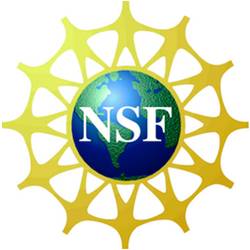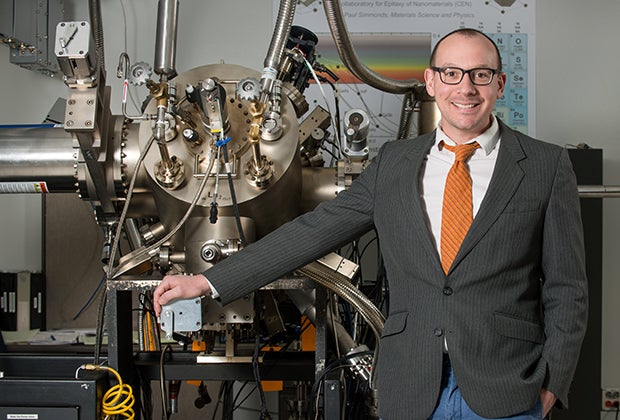Moore’s law, an observation made in 1965 by Gordon E. Moore that the overall processing speed of computers will double every two years, has governed research and development in the tech industry for years. But the physical limitations of standard silicon technology can’t support that kind of exponential growth forever. That means the industry is scrambling to find new ways to improve computer function. Paul Simmonds, an assistant professor in the Department of Physics, is working on the cutting-edge of that problem.
His work is being funded by a five-year, $510,000 CAREER Award from the National Science Foundation. The award is the NSF’s most prestigious program supporting junior faculty who effectively integrate outstanding research and education within the context of their organization’s mission. It is intended to give promising researchers an early career boost by providing stable research funding over an extended period of time.
Simmonds, who holds a joint appointment in the Department of Materials Science and Engineering, is looking to use his research into semiconductors and sub-atomic processes to contribute to this drive toward faster, smarter computers.
Titled “Novel Nanomaterials for Scalable Entangled Photon Emitters,” his project relies on an odd property known as quantum entanglement, or what Albert Einstein referred to as “spooky action at a distance.” Entanglement refers to an extremely strong connection between two quantum particles. According to quantum mechanics, entangled photons are “linked” together, such that a change to one of the two photons instantaneously affects the other.

“Even if they are a light year apart – which means it should take at least a year for information to travel between them – they communicate immediately,” said Simmonds. “But although we cancreate entangled photons, the precise nature of the link between them is not fully understood.”
Even so, by harnessing the power of entanglement, it is hoped that quantum computers will one day perform calculations much faster than today’s computers, and therefore keep Moore’s law alive. The sticking point in all of this is that we need a cheap, reliable way to create entangled photons.
This is where Simmonds comes in. He proposes using structures called quantum dots (or Q dots) that generate two photons in a single process. If the specifics of this process are controlled extremely carefully, it is possible to entangle these photons. But it’s tricky work. Q dots are nano-sized, about 30 nanometers wide by 5 nanometers tall. Q dots have been created in the lab for many years, but very few emit entangled photons.
“Right now we have to search for a few perfect Q dots among millions,” Simmonds said, noting that a recent study at Cambridge found that only about 1 percent of Q dots generate entangled photons. “But at an industrial scale, searching to find these ideal Q dots is time consuming, expensive and not practical. It’s not scalable.”
Simmonds realized that in order for the concept to work, researchers needed to find a way to manufacture Q dots so that in theory all of them would have the perfect properties for entanglement. His proposed solution focuses on a new kind of Q dot he has developed over several years. His Q dots contain the correct symmetry and structure to routinely and reliably create entangled photons. Results could help revolutionize computing and cryptography.
The grant also has an educational component. Simmonds will work with students in campus service learning courses, with iSTEM to provide workshops to allow teachers to present scientific concepts in their classrooms, and with the Discovery Center of Idaho’s Adult Night.
Simmonds is excited about the grant for several reasons.
“It does have a prestige to it,” he admitted. “But also, it’s a five-year award, not three like most grants. Most Ph.D. candidates don’t finish in three years, and so this grant ensures stable funding for students, and gives me enough time to help them develop as scientists and graduate.”
Simmonds is the latest in a growing number of Boise State faculty who have received CAREER Awards.
2015 — Claire Xiong (Materials Science and Engineering)
2014 — Alejandro Flores (Geosciences)
2014 — Vishal Saxena (Electrical and Computer Engineering)
2013 — Pushpa Raghani (Physics)
2012 — Jeffrey Johnson (Geosciences)
2011 — Inanc Senocak (Mechanical and Biomedical Engineering)
2009 — Wan Kuang (Electrical and Computer Engineering)
2007 — Megan Frary (Materials Science and Engineering)
2005 — Alex Punnoose (Physics)
2003 — Elisa Barney Smith (Electrical and Computer Engineering)
2001 — John Lusth (Computer Science — now at University of Alabama)
1997 — Susan Burkett (Electrical and Computer Engineering — now at University of Alabama)
In addition, Janet Callahan (Materials Science and Engineering) earned an NSF CAREER Award before coming to Boise State from the Georgia Institute of Technology. Kevin Ausman, an assistant professor in the Department of Chemistry and Biochemistry, brought a CAREER Award with him from Oklahoma State University.
This material is based upon work supported by the National Science Foundation under Grant No. 1555270. Any opinions, findings, and conclusions or recommendations expressed in this publication are those of the authors and do not necessarily reflect the views of the National Science Foundation.
BY: KATHLEEN TUCK PUBLISHED 9:32 AM / FEBRUARY 3, 2016
